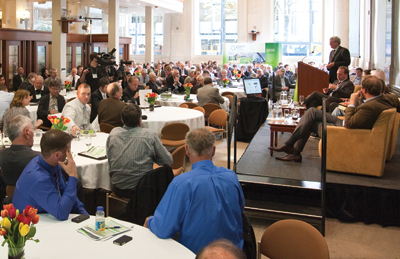
Torrefaction: Myth or Reality?
August 22, 2011
By Michael Weedon
Torrefaction and torrefied wood pellets are a hot topic in the world of bioenergy today. BC Bioenergy Network hosted a one-day conference on thesubject on May 12, 2011, in Vancouver.

|
| Conference attendees receive the latest information on the state of torrefaction technology.
|
Torrefaction and torrefied wood pellets are a hot topic in the world of bioenergy today. BC Bioenergy Network hosted a one-day conference on the subject on May 12, 2011, in Vancouver. It attracted bioenergy leaders from around the world to share the latest developments in torrefaction and the potential effects of displacing coal with torrefied, densified biomass for power generation.
Torrefaction involves heating the biomass in a range between 200 and 320°C, in an oxygen starved environment, to reduce moisture and transform biomass into a product with coal-like characteristics, which is typically further densified as either pellets or briquettes. Torrefied biomass has three major advantages over traditional biomass: increased calorific value (energy per unit of weight); increased energy density (energy per unit of volume); and improvements in a range of physical properties such as durability, homogeneity, and hydrophobic behaviour. This, in turn, leads to overall reduced costs of production and transportation, reduced storage area and facility requirements, and increased safety for storage handling facilities. This fuel type is attracting significant interest from coal utilities, particularly in Europe. Torrefied biomass or “biocoal” as it is often described, holds potential to significantly reduce greenhouse gas emissions by replacing coal with carbon-neutral biomass in cogeneration facilities, thus helping the utility industry meet the European mandated 2020 carbon reduction targets.
With the promise of lower costs and higher performance, torrefaction and torrefied wood pellets or briquettes have the potential to bring biomass to the market in much larger volumes, creating a new commodity market and ultimately reducing costs to customers and risk to investors.
So where are we today? There are several technology developers and suppliers moving quickly to take advantage of the growing interest from the utilities. BC Bioenergy Network co-funded a recent study in conjunction with the Wood Pellet Association of Canada to undertake a techno-economic review of a number of technology vendors and their applicability to the hosting conditions in British Columbia. The results were promising, with opportunities for a variety of torrefaction reactor designs driven by specific export markets, niche applications, type and quantity of feedstock, and degrees of integration with existing pellet operations. While the principles of conversion are similar, there are numerous entrepreneurs and technology developers. Many use different processes to achieve similar characteristics, and many are at various stages of pilot and commercial development.

|
|
| Michael Weedon is executive director of the BC Bioenergy Network, which hosted the conference.
|
At the conference, two of the leading technology developers provided encouraging updates on commercial production. Hervé Chauvin, president and CEO of France-based Thermya SA, shortly after the conference, announced construction of three industrial biocoal production units using Torspyd, the innovative biomass torrefaction process developed by the company, one in Spain and two in northern France. This follows their successful pilot plant in Bordeaux, France. Robin Post Van der Burg, business development director at
Topell Energy, a Netherlands-headquartered WNF-Cleantech Star 2011 Award winner, shared the most recent results at the Topell plant currently being commissioned in Duiven, Netherlands. With RWE Innogy investment demonstrating the utility sector’s confidence and initial results demonstrating torrefied pilot production of eight tonnes/hour, this project is on track. With a projected total of 60,000 tonnes/year of torrefied pellets, the average power plant can produce electricity for approximately 42,000 households. The conference also heard from John Bennett from Canadian Bio-Coal Ltd. in Vancouver, and Carl Rheuban from U.S.-based KeyFlame Energy Advisors about their plans to commission torrefied plants in British Columbia and the United States in the near future.
Bill Sinclair, Canadian Process Manager of Vattenfall, one of Europe’s largest utilities, confirmed that torrefied biomass, or “black pellets,” is a key part of Vattenfall’s plans to reduce their carbon emissions from 90 million to 65 million tonnes/year by 2020. Vattenfall’s CEO, Øystein Løseth, states: “We will strive to be one of the leaders when it comes to transforming the energy sector in Europe into something more sustainable and to decreasing our environmental impact. This is taking responsibility, and it simply makes good business sense to do so as well.” Black pellets are also seen to minimize downstream capital costs and help achieve high co-firing rates. Vattenfall is seeking to secure upstream supply at stable volume and cost, anticipating five million tonnes/year of black pellets by 2020. The price of torrefied biomass and the cost of coal are expected to cross sometime before 2020. With the avoided capital cost and the carbon reduction targets as drivers, Vattenfall can justify paying a little more to ensure development of this important fuel input.
With technology and upgrade cost hurdles seemingly reduced, torrefaction implementation success will now be focused on the development of supply chain and economic fibre costs. British Columbia, with its abundant fibre basket and well-established forestry and pellet industry, is well poised to become a major player in the supply of torrefied biomass. Several projects are under development in the province, and the first facilities could be under construction in the next 12 to 18 months. Synergistic partnerships between technology innovators, project developers, utilities, logistics companies, and investors are keys to positioning British Columbia as the North American and potentially global leader for torrefied biomass.
Myth no more, conference attendees expressed by straw vote. The reality is, torrefaction is here, and it will indeed be a game changer if we listen to the technology providers and enthusiasts.
Michael Weedon is executive director of the BC Bioenergy Network, an industry-led initiative that invests in technology development and demonstration, product commercialization and market development, and capacity-building initiatives to build a world-class bioenergy capability in British Columbia.
Print this page